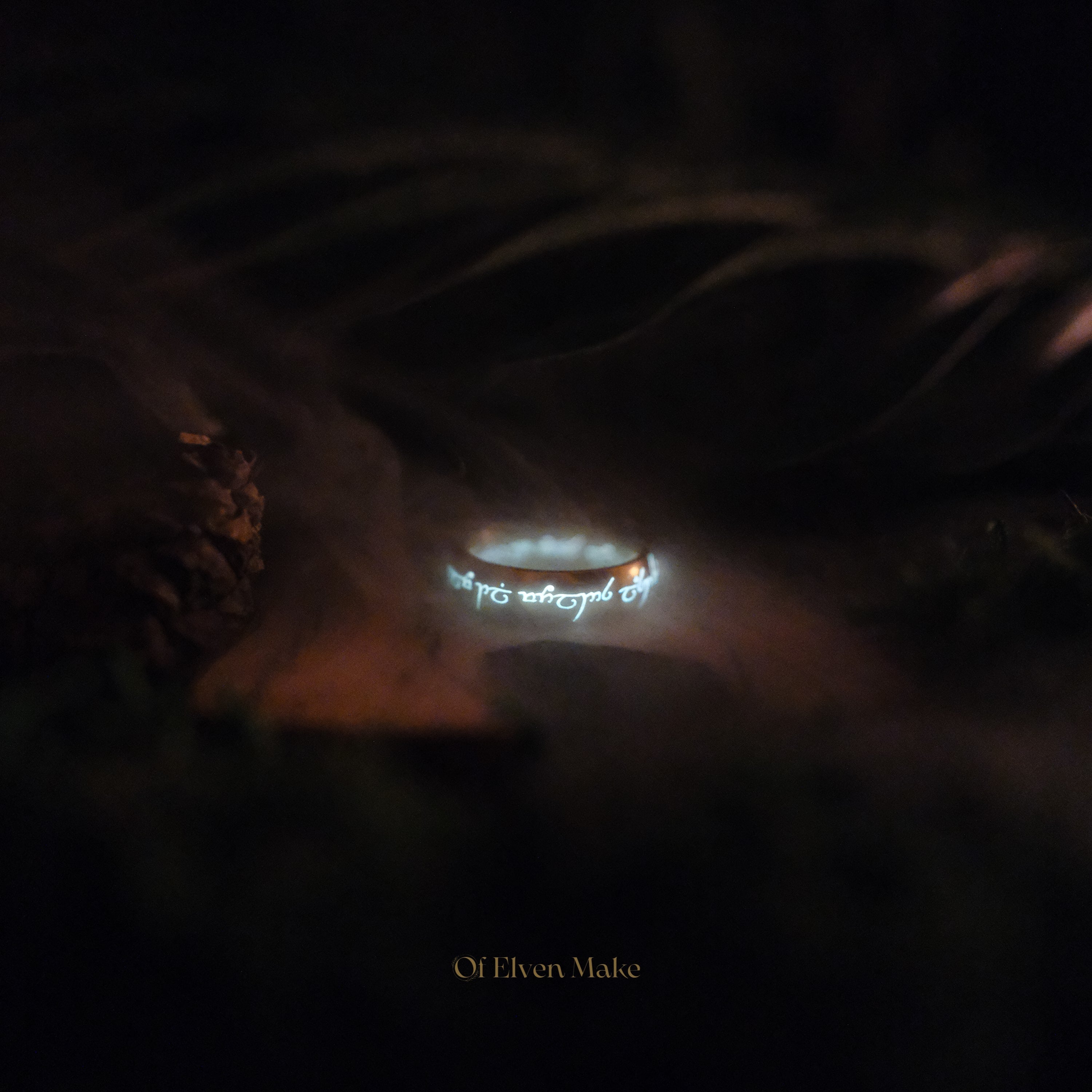Elvish Translator
Our Elven Rings
English to Elvish Translator
Instantly translate from English to a flowing Elvish language for free. Convert to Tolkien's Elven Quenya, Tengwar, Sindarin script, as seen in Lord of the Rings — LoTR.
A beginner's guide to Tengwar script
Tolkien's Elvish scripts represent one of the most intricate and beautiful writing systems ever created for fictional languages. The two main Elvish writing systems, Tengwar and Sarati, were developed by J.R.R. Tolkien as part of his extensive language creation work.

Learning to write English words in Elvish script primarily involves mastering the Tengwar system, which consists of 24 main letters that can be modified with additional marks to represent different sounds. The Tengwar writing system was designed to be adaptable to multiple languages, making it particularly suitable for transcribing English words.
The beauty of Elvish script lies in its flowing, calligraphic nature, inspired by medieval manuscripts and Arabic writing. While originally created for Tolkien's constructed Elvish languages, the script has been embraced by fans worldwide who use it to write messages in English and other modern languages.
History of Elvish Languages
J.R.R. Tolkien created multiple Elvish languages with rich histories, complex grammar rules, and extensive vocabularies. His two primary Elvish languages, Quenya and Sindarin, evolved through careful linguistic development spanning several decades.
Origin of Elvish Languages
Tolkien began developing his Elvish languages as early as 1910, drawing inspiration from Finnish, Welsh, and other natural languages. His professional background as a philologist greatly influenced the linguistic authenticity of these constructed languages.
The creation of Elvish languages predated his fictional works, serving as a foundation for the broader mythology of Middle-earth. These languages weren't merely artistic creations but fully developed communication systems with their own evolution and dialects.
Elvish in Tolkien's Works
Quenya became the ceremonial language of the High Elves, while Sindarin emerged as the common speech among Elves in Middle-earth. Both languages appear throughout The Lord of the Rings and The Silmarillion.
The two main writing systems for Elvish languages are:
- Tengwar: A cursive alphabet system
- Cirth: A runic writing system
Each Elvish language underwent historical changes within Tolkien's fictional timeline, mirroring real-world language evolution. The languages feature distinct grammatical structures, pronunciation rules, and writing conventions that remained consistent throughout his literary works.
Elvish Script Basics
The Tengwar writing system forms the foundation of Elvish script, utilizing a set of distinct characters to represent consonants and vowel markings called tehtar.
Overview of Tengwar
Tengwar is a phonemic writing system where each character represents a specific sound. The Fëanorian writing system consists of 24 primary letters arranged in four series of six characters each.
The four series are organized by place of articulation: dental, labial, palatal, and velar sounds. Each series contains variations based on how the sound is made.
Tengwar can be written in different modes, with the most common being the "full writing" mode where both consonants and vowels are represented by distinct symbols.
Understanding Tengwar Characters
Each Tengwar character consists of a telco (stem) and a lúva (bow). The stem can be short or long, while the bow can curve up or down on either side.
Basic consonants are represented by the primary character shapes, while modifications like doubling or aspirating are shown through additional marks.
Vowels in Tengwar can be written as separate letters or as diacritical marks above or below the consonants, depending on the mode being used. The most basic vowel marks are dots, acute accents, and curves.
The characters follow a logical pattern where similar sounds use similar shapes, making the system intuitive to learn despite its initial complexity.
The Tengwar Alphabet for English
The Tengwar script is a versatile writing system that can be adapted to write English words using its elegant, cursive-style characters.
English words written in Tengwar follow specific rules for consonant and vowel placement. The primary characters represent consonants, while vowels appear as diacritical marks above or below the main letters.
The basic Tengwar characters are arranged in a systematic table of four rows and six columns. Each row shares similar letter shapes, making the system logical to learn and remember.
When writing English in Tengwar, certain consonant combinations like "th," "ch," and "sh" use dedicated characters. Some English sounds require slight modifications to the traditional Elvish script system to accommodate all phonetic elements.
Common English vowels (a, e, i, o, u) are represented by distinctive marks called tehtar. These marks typically appear above the consonant that precedes them in pronunciation.
The direction of writing remains left to right, matching English convention. Numbers and punctuation marks have their own unique representations in the Tengwar system.
Key Features of English Tengwar:
- Consonants form the main letter bodies
- Vowels appear as diacritical marks
- Special characters for common English digraphs
- Maintains English reading direction
Writing in Elvish

The ancient Elvish languages of Quenya and Sindarin (previously known as Noldorin) utilize the elegant Tengwar script system, with specific rules for transcribing both Elvish words and English text using flowing letterforms.
Converting English to Tengwar
The Tengwar script consists of 24 primary letters called témar, arranged in four vertical series based on similar sounds. Each letter has a distinct shape with a vertical stem (telco) and curved bow (lúva).
English words can be written using Mode of Beleriand, which assigns specific Tengwar letters to English consonants and vowels. The vowels appear as full letters rather than diacritical marks.
Basic Tengwar letter correspondences:
- T = tinco (⸱)
- N = númen (⸲)
- R = rómen (⸳)
- W = wilya (⸴)
Names require special attention when converting to Tengwar. Proper nouns often use capital letters indicated by doubling the bow of the first letter.
Common Phrases in Elvish
The Quenya language serves as the High-Elven tongue, while Sindarin represents the more commonly used Grey-elven speech.
Essential Quenya greetings:
- Aiya - Hail
- Elen síla lúmenn’ omentielvo - A star shines on the hour of our meeting (as spoken in the movies)
- Namárië - Farewell
The Tengwar writing system uses flowing curves and elegant flourishes that give Elvish script its distinctive appearance. Each word flows naturally from left to right.
Short phrases work best for beginners learning to write in Tengwar. Start with simple greetings before attempting longer texts or complex passages.
Practical Applications of Elvish Script
Elvish script has evolved beyond its literary origins to become a popular choice for personal artistic expression and meaningful decorative elements. The elegant flowing lines and symbolic depth of Tengwar make it particularly suited for permanent and ornamental applications.
Elvish Tattoos
Please be aware that there are multiple ways to represent English words and phrases in Elvish. We do not claim to be experts in this field, nor do we guarantee the accuracy of the translations provided. Exercise caution before using any results for tattoos, inscriptions, or engravings.
Tengwar script offers unique aesthetic appeal for tattoo designs due to its graceful curved lines and vertical orientation.
Popular tattoo placements include forearms, wrists, and along the spine where the vertical flow of the script enhances the natural body lines.
Professional tattoo artists skilled in Elvish script ensure accurate translation and proper character formation. Common designs include names, meaningful quotes, and single words that hold personal significance.
Jewelry and Engraving
The practical application of Elvish script in jewelry has gained prominence through wedding bands and commitment rings. Many couples choose personalized inscriptions in Tengwar for their symbolic value.
We at Of Elven Make specialize in creating rings with authentic Elvish engravings. The process requires precise technique to maintain legibility at small scales.
Custom pieces often incorporate both the script and traditional Elvish design elements. Popular items include:
- Wedding bands with names or dates
- Pendant necklaces featuring meaningful phrases
- Signet rings with personal mottos
- Bracelet engravings with family names
Online Elvish Resources
Several reliable digital tools and educational platforms exist for learning and working with Elvish scripts and languages. These resources range from interactive translators to comprehensive learning modules.
Elvish Translators and Tools
Online translators like ours, Tengwar Scribe, Tecendil, etc., specifically handle the conversion of English text into Tengwar script with proper mode selection and character placement. However, all such tools are more like transliteration if used without an Elvish dictionary since they only map Latin letters to a Tengwar script based on phonetic rules.
For a proper translation, one should take words or phrases from an Elvish dictionary and input them into an Elvish translator, such as Elen síla lúmenn’ omentielvo.
Parf Edhellen serves as a comprehensive dictionary and translation database for multiple Elvish dialects. The platform includes word lookup features and etymology details.
The Vinyar Tengwar academic journal maintains a digital presence, offering scholarly articles and updates about Elvish linguistics and writing systems.
Learning Elvish Script Online
Free courses like Elvish 101 provide structured lessons focusing on basic character recognition and writing techniques. These typically include practice exercises and pronunciation guides.
Interactive learning platforms offer step-by-step guidance for mastering Tengwar and runic scripts, complete with visual aids and practice sheets.
Digital communities centered around Neo-Sindarin provide forums for learners to share resources, ask questions, and participate in writing exercises.
Many platforms include downloadable practice sheets and font packages for creating authentic-looking Elvish text on computers.
Frequently Asked Questions

Accurate translation and script writing require careful attention to Tolkien's established linguistic rules and authentic resources. The process demands understanding both the technical aspects of Elvish language creation and proper script formation.
How can I translate English to Elvish accurately?
Direct word-for-word translation from English to Elvish often produces incorrect results. Language structure and grammar rules differ significantly between the two languages.
Professional translation requires studying Quenya or Sindarin grammar rules and sentence structures specifically.
What are the best resources for finding an Elvish translator?
Respected Elvish language communities maintain curated dictionaries and translation guides online. Several academic institutions offer verified Elvish language study materials.
Digital tools should be cross-referenced with established Tolkien linguistics texts for accuracy.
Where can I learn the Elvish alphabet and script?
The Tengwar writing system forms the foundation of Elvish script. Learning materials are available through dedicated Tolkien language websites and academic publications.
Basic character shapes and combinations can be practiced using downloadable practice sheets.
How can I write my name in Elvish?
To write your name in Elvish, simply write your name with Latin characters in the Elvish translator above. However, keep in mind that name conversion requires understanding phonetic equivalents in Elvish rather than direct letter substitution. Each name needs individual analysis based on pronunciation and meaning.
Cultural context and proper sound combinations must be considered for authentic name translation. But for the most part, it will be accurate.
Is there an Elvish writing generator available online?
Digital Tengwar generators like ours exist but require verification against established writing rules. Font packages enable proper script display on modern devices.
Manual script writing provides better control over character formation and connecting elements.
How is pronunciation represented in Elvish translation?
Elvish uses specific diacritical marks to indicate proper pronunciation. Each vowel and consonant combination follows strict phonetic rules.
Stress patterns and syllable emphasis differ from English pronunciation conventions.










